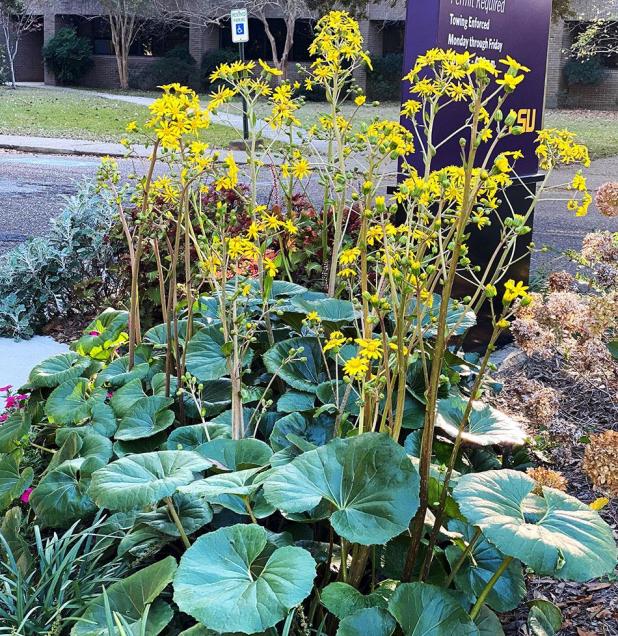
Ligularia’s large, coarse, glossy green leaves that resemble tractor seats is the reason it is commonly called a tractor seat plant.
—LSU AgCenter/Heather Kirk-Ballard
Get It Growing: Tractor seat plant brings color to fall, winter
If you are looking to add a splash of bright color to shaded areas in the fall and early winter, ligularia is an excellent choice. Many people commonly refer to it as tractor seat plant, as the shape of the leaf resembles one. It’s also sometimes called leopard plant, but no matter what you call it, ligularia’s large, glossy, deep green foliage makes a great addition to the landscape.
The plant’s most impressive feature is the lush foliage, which can add a tropical feel to temperate gardens. There are several types of ligularias. Each variety has its own unique leaf shape, floral variations and plant size.
An herbaceous perennial native to Asia, ligularia (Ligularia spp.) grows well in USDA hardiness zones 3 to 8 and does very well in Louisiana. Plants grow best in a rich organic soil and can tolerate wet conditions, making them a great addition to low areas that hold water or in rain gardens.
Ligularia is prized for its foliage just as much as it is for its beautiful yellow flowers, which appear in late fall and early winter. The large, leathery, glossy green leaves can provide a striking visual contrast to finer-textured foliage in the garden. Flowers form in a cluster of daisy-like heads that are 2- to 3-inches across in a deep yellow color. The tall stalks make an excellent selection for cut flowers.
Plants have a compact mounding form with a moderate growth rate. Growing to an average height of 2 to 3 feet with leaves that grow to an average of 3 to 4 inches, although some varieties’ leaves can reach 10-inches across.
Plants are clumping, so they should be divided every three to four years to keep plants growing vigorously and producing flowers. Plants are best divided when they are dormant, typically in early spring. They also can be divided in very late summer. Division of clumps and establishment is easy with adequate watering.
Be sure to keep newly divided plants well watered after being transplanted. Ligularias require constant moisture for the best performance. Water in summertime when temperatures rise or in extended droughts. Plants wilt in intense sun; they prefer partially shaded locations. Plants benefit from occasional fertilizing with liquid fertilizer or a slow-release, all-purpose, granular fertilizer in the spring and again in the fall.
Plants can freeze in extended lower temperatures in the winter, but plants normally return from roots in early spring. Remove damaged leaves in late winter.
Ligularias have no major pests or disease problems. Slugs appear to be fans of the plant, munching holes in leaves. Those damaged leaves can be removed, or you can try slug baits of your choice if heavy infestations occur. Japanese beetles can sometimes be a problem as well.
There are some interesting varieties available. Britt-Marie Crawford is one of the most popular varieties, reaching a height of 2 to 3 feet with leaves that display a chocolate-maroon color. Leaves are coarsely toothed and kidney-shaped.
The Rocket variety has finer-textured flowers that appear as though an explosion has gone off. Foliage is less rounded and triangular with irregular, ragged edges. Little Lantern is a smaller variety reaching an average height of 2 feet. The flower spires are profuse with golden, daisy-like flower clusters. A newer variety, Osiris Café Noir, has dramatic black-purple foliage with an arrowhead-shaped leaf with large, jagged, irregular edges.
